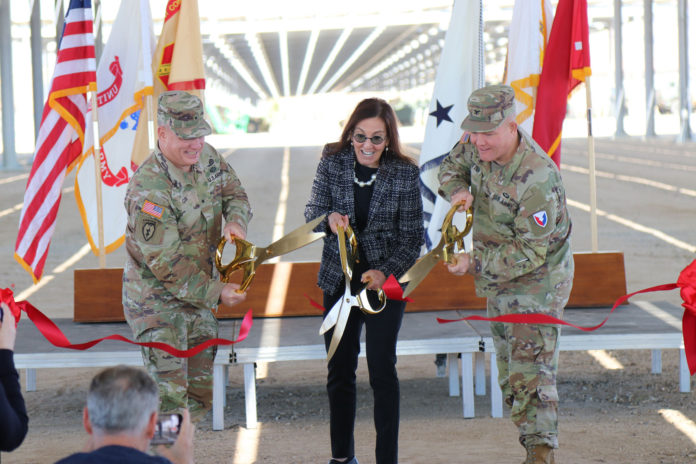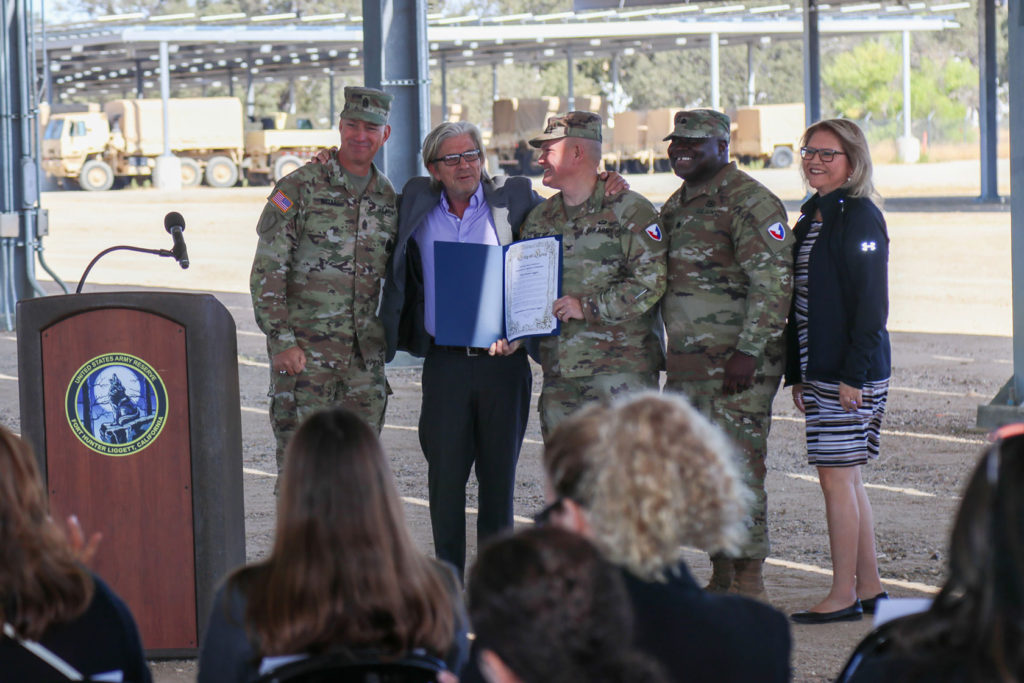
JOLON — The U.S. Army Garrison Fort Hunter Liggett, under the command of Col. Stephen Trotter, celebrated a landmark achievement Sept. 17 with the ribbon-cutting ceremony for its new microgrid, a fully renewable energy system designed to bolster the base’s energy resilience and sustainability.
The microgrid project, initiated in 2011, makes Fort Hunter Liggett the first Department of Defense installation to operate a microgrid powered entirely by renewable energy.
The event was attended by a distinguished group of guests, including the Hon. Rachel Jacobson, assistant secretary of the Army for installations, energy and environment; Mayor Mike LeBarre of King City; and Commissioner Naomi Gallardo of the California Energy Commission. Brig. Gen. Christopher Cook, deputy commanding general support of the 63rd Readiness Division, and Col. Chad Caldwell of the U.S. Army Corps of Engineers Sacramento Division also participated in the ceremony.
Col. Trotter acknowledged the long journey to this achievement.
“I took the energy resilience torch when I assumed command last year,” he said. “This milestone would not be possible without the partnership of multiple government and private organizations.” He emphasized the challenges faced by the installation, particularly the frequent power outages due to California’s wildfire season, which underscored the need for a resilient energy system.
Brig. Gen. Cook emphasized the strategic importance of the microgrid, saying, “This microgrid ensures that our critical facilities can continue to operate when the commercial grid is compromised.” He praised Fort Hunter Liggett as “the tip of the spear for training, supporting both active and reserve components in collective and individual training.”
Cook highlighted how the microgrid advances the Army’s goal of making its installations less dependent on the commercial grid, stating, “The award-winning energy resiliency program here at Fort Hunter Liggett is a demonstration that we can leverage Army programs and enterprise expertise to increase energy resilience with on-site generated power and renewable resources.”
The microgrid at Fort Hunter Liggett features cutting-edge technology, including solar panels, a 5-megawatt-hour battery storage system, and a microgrid control system. It was designed and constructed through a partnership with Ameresco, the U.S. Army Corps of Engineers, and other government and private partners.
Col. Caldwell, representing the U.S. Army Corps of Engineers Sacramento Division, described the microgrid as a “small, flexible electrical system that can function independently or in coordination with a larger power grid.”
Jarrod Ross, the garrison’s resource efficiency manager, provided insight into the project’s background. He noted that the effort to achieve energy resilience at Fort Hunter Liggett began in 2008, driven by the base’s location at the end of the utility grid in a remote area of California.
“We were already aware there were a lot of difficulties with power assurance here,” Ross said. “It looked like a good way, even back then, to try to provide some energy assurance to the garrison so we could continue the mission even if the utility grid is down.”

Ross further explained that the microgrid operates using solar generation and battery storage without relying on carbon-based energy sources like diesel generators, making it unique among Army installations.
“We are the first renewables-only microgrid,” he said.
This system allows Fort Hunter Liggett to remain operational for up to 14 days in case of a utility outage, significantly enhancing its energy resilience.
Mayor LeBarre presented a proclamation recognizing Fort Hunter Liggett’s commitment to energy resilience and its role as a premier total force training center. Commissioner Gallardo lauded the military’s efforts to transition from fossil fuels to clean energy.
“The military branches have been fantastic partners to us,” she said, emphasizing the importance of the partnership between the California Energy Commission and the military in achieving a clean energy future.
Jacobson, the assistant secretary of the Army for installations, energy and environment, underscored the broader significance of the project.
“This is the first installation in the Army to initiate a fully carbon-free microgrid,” she said. “It is a terrific accomplishment that should set the standard for everybody else.”
Brig. Gen. Cook further noted the broader impact of Fort Hunter Liggett’s efforts, highlighting the division’s intention to replicate the success of this project.
“The division is using lessons learned from this project to plan and execute microgrid projects at critical facilities throughout the region,” he said.
Cook also commended the Fort Hunter Liggett team, adding, “Through your hard work on many initiatives such as this, you are making sure that the Army Reserve soldiers are training and prepared for our next fight.”
Ross detailed plans to expand the microgrid, including additional battery storage and upgrades to older solar arrays. He emphasized the importance of continued innovation and resilience in military installations.
“The idea for our Army installations is to develop that mission-critical resilience so that in the event there is a mission to perform, we’re not dependent on the public electric grid,” Ross said. He also noted the importance of cybersecurity in protecting the microgrid from potential threats.
The ceremony concluded with the official ribbon-cutting and the activation of the microgrid. This project serves as a testament to Fort Hunter Liggett’s dedication to energy resilience and sustainability, with further expansion planned to achieve the goal of 100% net-zero energy.
Under the leadership of Col. Trotter and with the expertise of Brig. Gen. Cook, Ross and Col. Caldwell, the microgrid at Fort Hunter Liggett not only secures energy independence for the installation but also serves as a model for future Army initiatives, showcasing the potential for military installations to lead the way in adopting renewable energy solutions.














